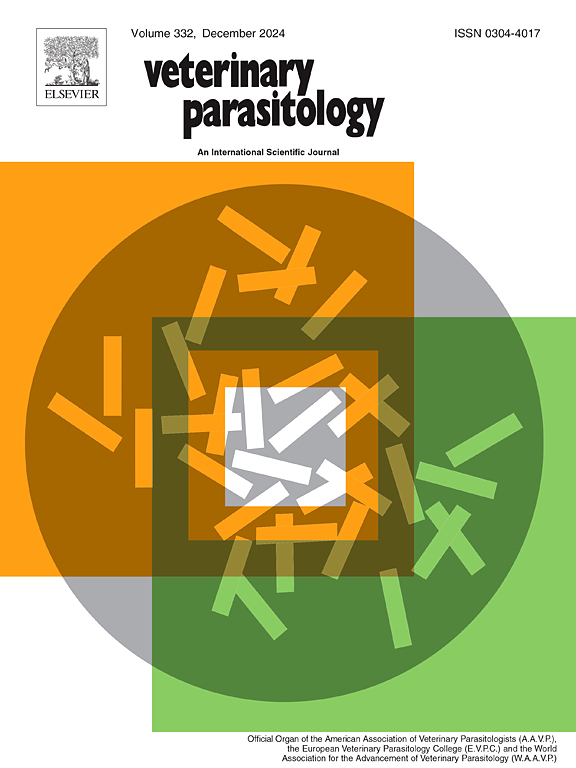以微量矿物质混合饲料饲喂羔羊对减少粪便中胃肠道线虫幼虫发育的影响
IF 2
2区 农林科学
Q2 PARASITOLOGY
引用次数: 0
摘要
在牲畜的饮食中提供捕获线虫的真菌,鞭毛虫的孢子,导致牧场上胃肠道线虫(GIN)幼虫的减少。目的是确定flagrans (Df;BioWorma®)与天然感染羔羊(主要是弯曲血蜱和毛线虫/Teladorsagia)的饲料补充剂相比,以矿物质混合物喂养,以减少培养的GIN幼虫数量。在初步试验中,试验羔羊分别饲喂不含Df (CON)或添加Df (n = 8/处理)的对照饲料7 d,以考察Df孢子的效果。每隔一天收集粪便进行三次共培养。饲喂Df可使3期强蝇幼虫减少73% % (P = 0.005)。试验2:断奶羔羊分别饲喂不添加Df (CON)、Df混合饲料(DfC)和微量矿物质饲料(DfM)中添加微量矿物质的粗蛋白质粒添加量为12% %;N = 8/次治疗)16天。Df组和Df组的幼虫复原率均降低(P <; 0.001),DfM组的第三期幼虫复原率低于DfC组(P = 0.001)。在一项实地研究中,使用断奶羔羊进行了为期30天的类似处理(n = 16只/处理,包括2组/处理)。饲喂16 %粗蛋白质商品谷物混合料和商品矿物混合料;DfM组在饲喂前7 d将Df孢子与矿物混合物混合。同样,两组Df均降低了强势幼虫的恢复(P <; 0.001),但Df处理之间相似(P = 0.62)。处理后的圆线虫幼虫回收率无显著差异(P = 0.181)。在微量矿物质混合物中加入Df,对于不提供谷物补充剂的牧场或牧场的羊群来说,有望控制GIN。本文章由计算机程序翻译,如有差异,请以英文原文为准。
Efficacy of Duddingtonia flagrans spores fed in trace mineral mix to lambs in reducing the development of gastrointestinal nematode larvae in feces
Providing spores of the nematode-trapping fungus, Duddingtonia flagrans, in the diet of livestock leads to fewer gastrointestinal nematode (GIN) larvae on pasture. The objective was to determine the efficacy of D. flagrans (Df; BioWorma®) fed in a mineral mix compared with a feed supplement to naturally infected lambs (predominantly Haemonchus contortus and Trichostrongylus/Teladorsagia spp.) to reduce the number of GIN larvae cultured. Initially, the efficacy of Df spores was examined in a preliminary experiment in which lambs were fed a control supplement without Df (CON) or with Df (n = 8/treatment) for 7 days. Feces were collected every other day for three coprocultures. Feeding Df led to a 73 % reduction in stongylid third-stage larvae (P = 0.005). In the second experiment, weaned lambs were fed a 12 % crude protein grain supplement with trace mineral added without Df (CON), Df mixed in feed (DfC) or in trace mineral (DfM; n = 8/treatment) for 16 days. Strongylid larval recovery was reduced in both Df groups (P < 0.001), and the third-stage larval recovery was lower in DfM than DfC (P = 0.001). In a field study, similar treatments were used (n = 16/treatment including 2 reps/treatment) using weaned lambs for a 30-day period. The sheep were fed a 16 % crude protein commercial grain mix and a commercial mineral mix; for the DfM group, Df spores were mixed with the mineral mix 7 days prior to feeding. Similarly, strongylid larval recovery was reduced in both Df groups (P < 0.001) but was similar between Df treatments (P = 0.62). No treatment effect on Strongyloides larvae recovered was noted (P = 0.181). Including Df in a trace mineral mix offers promise in control of GIN on pasture or range for flocks that do not offer grain supplements.
求助全文
通过发布文献求助,成功后即可免费获取论文全文。
去求助
来源期刊

Veterinary parasitology
农林科学-寄生虫学
CiteScore
5.30
自引率
7.70%
发文量
126
审稿时长
36 days
期刊介绍:
The journal Veterinary Parasitology has an open access mirror journal,Veterinary Parasitology: X, sharing the same aims and scope, editorial team, submission system and rigorous peer review.
This journal is concerned with those aspects of helminthology, protozoology and entomology which are of interest to animal health investigators, veterinary practitioners and others with a special interest in parasitology. Papers of the highest quality dealing with all aspects of disease prevention, pathology, treatment, epidemiology, and control of parasites in all domesticated animals, fall within the scope of the journal. Papers of geographically limited (local) interest which are not of interest to an international audience will not be accepted. Authors who submit papers based on local data will need to indicate why their paper is relevant to a broader readership.
Parasitological studies on laboratory animals fall within the scope of the journal only if they provide a reasonably close model of a disease of domestic animals. Additionally the journal will consider papers relating to wildlife species where they may act as disease reservoirs to domestic animals, or as a zoonotic reservoir. Case studies considered to be unique or of specific interest to the journal, will also be considered on occasions at the Editors'' discretion. Papers dealing exclusively with the taxonomy of parasites do not fall within the scope of the journal.
 求助内容:
求助内容: 应助结果提醒方式:
应助结果提醒方式:


